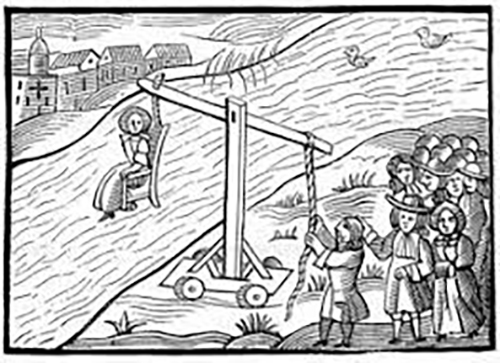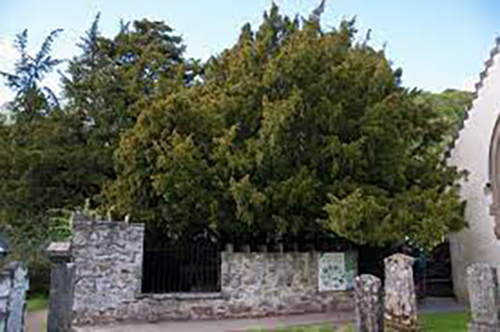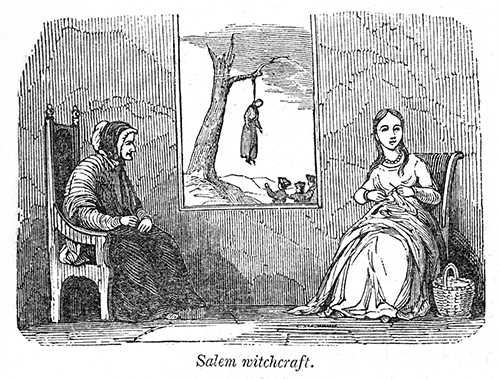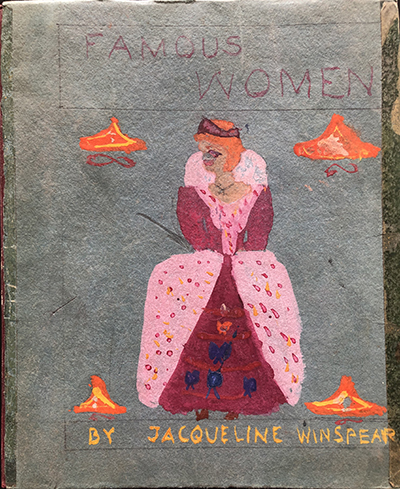If there is one word guaranteed to bring some level of emotion to people, it’s “witch.” There were those who burned the Harry Potter books due to the appearance of broomsticks and so-called “magic” – though J.K. Rowling didn’t mind at all, because to burn books you have to buy them first. I think she said words to the effect of “Bring it on” – and who could blame her? And who doesn’t want to believe in a little magic every now and again? However, I remember the first time I realized the depth of tragedy in the accusation of being a witch. I was a child at the time, walking with my parents in Canterbury, the cathedral town in Kent, England, the county where I was born and raised. It is my true home. As we walked on the bridge over a river, I looked across and saw a ducking stool, so of course I wanted to know what it was.
 Ducking stool in Canterbury, Kent, England
Ducking stool in Canterbury, Kent, England
If you’ve never heard of a ducking stool, here’s how it was used in the Middle Ages. A woman accused of witchcraft would be tied into the stool and the stool released into the water, so she was completely immersed. If she was still alive after the drowning, then she was deemed a witch. If she was dead, she was innocent of the crime. Either way, she was doomed.

In the Middle Ages, it is estimated that tens of thousands of women were slaughtered across Europe due to the accusation of witchcraft. I remember reading a statistic suggesting the number was way off, and that in reality, it was akin to a holocaust, with female deaths running into the hundreds of thousands. One particularly brutal form of killing was to drive a wooden stake through the heart of a woman, however, this stake had a leather lanyard attached, so the men (and it always seemed to be men, but women were not innocent of killing other women – often to save themselves) could pull the stake out and ram it into the woman’s heart time and again. Then, as we know, there was burning at the stake, drowning, being stoned to death, buried alive, one stone or shovel-full of earth at a time and all manner of other brutal endings. But were these women engaging in some sort of collaboration with the devil? No, but they were chiefly women of wealth, or women who were healers, or women who saw fit to worship the seasons and the earth under their feet – what might be called “pagans” today. Nothing wrong with worshipping the earth – we might not be in such a mess if we’d done a bit more of it over the years. But let’s look at those women again.
 Women worshipping the earth
Women worshipping the earth
Given the number of men killed in early religious wars in particular (between the 1400-1700’s), and later any old war you can think of, a number of women became quite wealthy due to inheritance of land and money. With money comes a certain power, and the men in power were a bit put off by that. They wanted to get their hands on the money too, and of course the land – so what do you do if you’re of that mind at a time when the power brokers were men? You turn the community against any powerful women, and one of the best ways is to promote fear. It’s a time-honored technique – people can be so manipulated by fear. You accuse the women of witchcraft, after all, how else would they have become so wealthy if it weren’t for some sort of kinship with the devil? Bingo – you soon have a whole village turning out against those women. And if the women were of a certain age, they were probably stooped, and even had some chin and nose hairs, which of course added to the evidence, along with wearing black because they were widows.

Then there’s the next driver of violence against women accused of witchcraft. Around the Middle Ages, men began practicing medicine in greater numbers. Medical schools were founded, and men became the physicians. Until then, women were the healers. Because women used plants and shrubs for cooking, they understood the healing powers inherent in plants, in the natural world – and if men wanted to make money out of medicine, they had to get rid of the women doing the healing without charge or using a barter system. Oh, there you go – let’s accuse the women of witchcraft, and that’s it – we’ve got the market!

Another reason for those terrible witch hunts of early modern history, was the rise in Christianity and the potential for power that many politicians saw in co-opting religious belief for their own troubling purposes – something we see a lot of today. But if you are in Britain and many other places across Europe, you will see evidence of how those early power brokers were really good at marketing. It’s the yew tree outside almost every ancient church.

The yew tree is an evergreen known for its ability to live for over one thousand years – indeed in Defynnog, Wales, there is a yew thought to be 5000 years old (yews don’t have trunk rings so it’s hard to estimate age) and another in Scotland of the same vintage. The yew can sprout new shoots from what appears to be dead wood – and the anti-cancer drug, Taxol, is from the yew tree. I remember reading, years ago, that the remains of yew had been found in the digestive matter in centuries-old corpses found at an archeological dig – with further investigation suggesting that the deceased had suffered with stomach cancer. The yew was revered by early people (yes, those people we now call “pagan”), because with the ability to retain its dark green foliage throughout the year and endure all manner of weather conditions, the yew represented not only everlasting life, but survival in hard times. A yew tree became a community gathering place, to give thanks for the bounty on earth and to petition the goddesses of nature to bring light again – it was a place of worship. Those early Christian men took one look at where the pagans were meeting and set up shop right there. It’s a bit like opening a Starbucks in a Safeway, or right next door to an Abercrombie and Fitch – go for the target audience over whom you want to exert power.

Let’s return to those poor women dunked in water, burned at the stake or murdered by any other brutal means. I started to write this post a few weeks ago, because in the news almost every day there is a story indicating that attacks on women are rising at a fear-inducing trajectory around the world. Those attacks are physical, verbal, emotional, psychological, professional – oh and let’s not forget “medical” – and seem to be escalating as women have gained more opportunity and therefore more power. It was therefore serendipitous, that as I sat down to finish this piece a news item popped up on my screen – apparently, a woman named Elizabeth Johnson, Jr, who was sentenced to death in 1693 in Salem, Massachusetts, has finally been cleared of witchcraft. At her trial, Elizabeth confessed to being a witch – along with 20 members of her family – yet was never actually killed. There is evidence to suggest she confessed because those women who maintained their innocence were murdered anyway, so she decided to take her chances with a lie. In addition, she was possibly suffering from some sort of mental disability which would have made her a target. At the heart of Elizabeth’s exoneration was the work of middle-schoolers in a civics class project at North Andover Middle School. Let’s hear it for teacher Carrie LaPierre who directed the project in her eighth-grade class. “We called her E.J.J., all the kids and I,” said Ms. LaPierre. “She just became one of our world, in a sense.”


